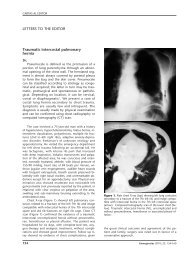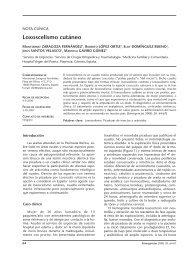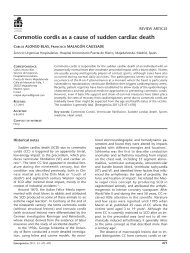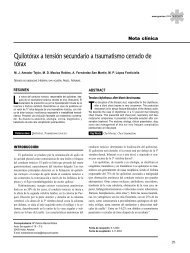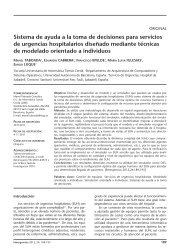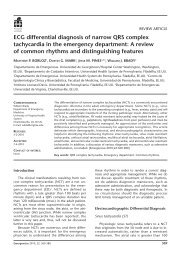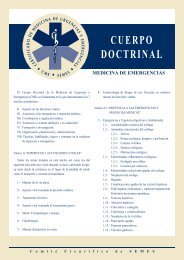Secuencia de intubación rápida - Semes
Secuencia de intubación rápida - Semes
Secuencia de intubación rápida - Semes
Create successful ePaper yourself
Turn your PDF publications into a flip-book with our unique Google optimized e-Paper software.
F. M. Parrilla Ruiz et al.<br />
layo Martínez E. Vali<strong>de</strong>z <strong>de</strong> la distancia tiromentoniana como predictor<br />
<strong>de</strong> vía aérea difícil en medicina extrahospitalaria. Emergencias.<br />
2011;23:246.<br />
7 Herrerías Lloréns J. Inducción anestésica <strong>de</strong> secuencia rápida. Rev Esp<br />
Anestesiol Reanim. 2003;50:87-96.<br />
8 Fakhry S, Scanlon J, Robinson L, Askari R, Watenpaugh R, Fata P, et<br />
al. Prehospital Rapid Sequence Intubation for Head Trauma: Conditions<br />
for a Successful Program. J Trauma. 2006;60:997-1001.<br />
9 Walls RM, Murphy MF. The difficult airway in adults. Update 2011.<br />
(Consultado 8 Septiembre 2011). Disponible en: http://www.uptodate.com/contents/the-difficult-airway-in-adults?<br />
10 Reed MJ, Dunn MJG, McKeown DW. Can an airway assessment score<br />
predict difficulty at intubation in the emergency <strong>de</strong>partment? J<br />
Emerg Med. 2005;22:99-102.<br />
11 Hyuk Joong C, Hyung-Goo K, Tae Ho L, Hyun Soo C, Junho C,<br />
Young-Min O, et al. Endotracheal intubation using a Gli<strong>de</strong>Scope vi<strong>de</strong>o<br />
laryngoscope by emergency physicians: a multicentreanalysis of<br />
345 attempts in adult patients. J Emerg Med. 2010;27:380-2.<br />
12 Nee PA, Benger J, Walls RM. Airway management. J Emerg Med.<br />
2008;25:98-102.<br />
13 Matthew JR. Intubation training in emergency medicine: a review of<br />
one trainee’s first 100 procedures. J Emerg Med. 2007;24:654-6.<br />
14 Bair A, Caravelli R, Tyler K, Laurin E. Feasibility of the preoperative<br />
mallampati airway assessment in emergency <strong>de</strong>partment patients. J<br />
Emerg Med. 2010;38:677-80.<br />
15 Reynolds S, Heffner J. Airway management of the critically ill patient.<br />
Rapid-sequence intubation. Chest. 2005;127:1397-412.<br />
16 Dargin J, Medzon R. Emergency <strong>de</strong>partment management of the airway<br />
in obese adults. Ann Emerg Med. 2010;56:95-104.<br />
17 Weingart SD. Preoxygenation, reoxygenation, and <strong>de</strong>layed sequence intubation<br />
in the emergency <strong>de</strong>partment. J Emerg Med. 2011;40:661-7.<br />
18 Davis DP, Douglas DJ, Koenig W, Carrison D, Buono C, Dunford J.<br />
Hyperventilation following aero-medical rapid sequence intubation<br />
may be a <strong>de</strong>liberate response to hypoxemia. Resuscitation.<br />
2007;73:354-61.<br />
19 Benumof J, Dagg R, Benumof R. Critical hemoglobin <strong>de</strong>saturation<br />
will occur before return to an unparalized state following 1 mg/kg<br />
intravenous succinylcholine. Anestesiology. 1997;87:979-82.<br />
20 Levitan RM, Chudnofsky C, Sapre N. Emergency airway management<br />
in a morbidly obese, noncooperative, rapidly <strong>de</strong>teriorating patient.<br />
Am J Emerg Med. 2006;24:894-6.<br />
21 El Solh AA. Airway Management in the Obese Patient. Clin Chest<br />
Med. 2009;30:555-68.<br />
22 Lo<strong>de</strong>r WA. Airway Management in the Obese Patient. Crit Care Clin.<br />
2010;26:641-6.<br />
23 Baskett P JF, Baskett TF. Brian Sellick, Cricoid Pressure and the Sellick<br />
Manoeuvre. Resuscitation. 2004;61:5-7.<br />
24 Elizabeth Mace S. Challenges and Advances in Intubation: Airway<br />
Evaluation and Controversies with Intubation. Emerg Med Clin N<br />
Am. 2008;26:977-1000.<br />
25 Mower WR, Knopp RK. Clinical controversies: lidocaine administration<br />
before rapid sequence intubation in patients with traumatic<br />
brain injuries. Ann Emerg Med. 2007;49:84-6.<br />
26 ilber SH. Rapid Sequence Intubation in adults with elevated intracranial<br />
pressure: A survey of emergency medicine resi<strong>de</strong>ncy programs.<br />
Am J Emerg Med. 1997;15:263-7.<br />
27 Juul N, Duch B, Rasmussen M. Clinical management of patients with<br />
head injury. Curr Anaesth Crit Care. 2009;20:132-7.<br />
28 Thomas SH, Benevelli W, Brown DFM, We<strong>de</strong>l S. Safety of fentanyl for<br />
analgesia in adults un<strong>de</strong>rgoing air medical transport from trauma<br />
scenes. Air Med J. 1996;15:2:57-9.<br />
29 Bernard S, Nguyen V, Cameron P, Masci K, Fitzgerald M, Cooper DJ,<br />
et al. Prehospital rapid sequence intubation improves functional outcome<br />
for patients with severe traumatic brain injury. Ann Surg.<br />
2010;252:959-65.<br />
30 Taylor EJS, Feneck RO, Chambers DJ. Fentanyl and myocardial protection:<br />
is there a preconditioning mechanism? Crit Care.<br />
2001;5:(Supl 4).<br />
31 Mularski RA. Pain management in the intensive care unit. Crit Care<br />
Clin. 2004;20:381-401.<br />
32 Gindre S, Ciais JF, Levraut L, Dellamonica J, Guerin J, Grimaud D. Rapid<br />
sequence intubation in emergency: is there any place for the<br />
fentanyl? Ann Fr Anesth Reanim. 2002;21:760-6.<br />
33 Brenner B, Corbridge T, Kazzi A. Intubation and mechanical ventilation<br />
of the asthmatic patient in respiratory failure. J Allergy Clin Immunol.<br />
2009;124:19-28.<br />
34 Brenner B, Corbridge T, Kazzi A. Intubation and mechanical ventilation<br />
of the asthmatic patient in respiratory failure. J Emerg Med.<br />
2009;37:S23-S34.<br />
35 Bottor LT. Rapid Sequence Intubation in the Neonate. Adv Neonatal<br />
Care. 2009;9:111-7.<br />
36 Agrawal D. Rapid sequence intubation in children. Uptodate 2011.<br />
(Consultado 21 Septiembre 2011). Disponible en: http://www.uptodate.com/contents/rapid-sequence-intubation-inchildren?<br />
source=search_result&selectedTitle=1%7E33#H15.<br />
37 Devlin JW, Roberts RJ. Pharmacology of commonly used analgesics<br />
and sedatives in the ICU: benzodiazepines, propofol, and opioids.<br />
Crit Care Clin. 2009;25:431-49.<br />
38 Thomas SH, Shewakramani S. Prehospital trauma analgesia. J Emerg<br />
Med. 2008;35:47-57.<br />
39 Bledsoe GH, Schexnay<strong>de</strong>ry SM. Pediatric rapid sequence intubation.<br />
A Review. Pediatr Emerg Care. 2004;20:339-44.<br />
40 Gerardi MJ, Sacchetti AD, Cantor RM, Santamaria JP, Gausche M,Lucid<br />
W, et al. Rapid-sequence intubation of the Pediatric Patient. Ann<br />
Emerg Med. 1996;28:55-74.<br />
41 Horvath II PR, Mayberry R, Franklin K, Ekbla G. The Medication-Assisted<br />
Intubation Matrix © : A Literature Review and Evi<strong>de</strong>nce-Based Gui<strong>de</strong>lines.<br />
Ann Emerg Med. 2007;50:111.<br />
42 Sivilotti MLA, Filbin MR, Murray HE. Does the Sedative Agent Facilitate<br />
Emergency Rapid Sequence Intubation? Acad Emerg Med.<br />
2003;10:612-20.<br />
43 Forman SA. Clinical and molecular pharmacology of etomidate.<br />
Anesthesiology. 2011;114:695-707.<br />
44 Pandit JJ. Intravenous anaesthetic agents. Anaesth Intensive Care.<br />
2010;12:144-50.<br />
45 Hool AJ, Kitson RM. Induction of anaesthesia. Anaesth Intensive Care.<br />
2009;11:25-31.<br />
46 Huter L, Schreiber T, Gugel M, Schwarzkopf K. Low-dose intravenous<br />
midazolam reduces etomidate-induced myoclonus: a prospective,<br />
randomized study in patients un<strong>de</strong>rgoing elective cardioversion.<br />
Anesth Analg. 2007;105:1298-302.<br />
47 Hohl CM, Kelly-Smith CH, Yeung TC, Sweet D, Doyle-Waters M,<br />
Schulzer M. The effect of a bolus dose of etomidate on cortisol levels,<br />
mortality, and health services utilization: a systematic review.<br />
Ann Emerg Med. 2010;56:105-13.<br />
48 Jones AE. The etomidate <strong>de</strong>bate. Ann Emerg Med. 2010;56:490-1.<br />
49 Dmello D, Taylor S, O’Brien J, Matubchak GM. Outcomes of etomidate<br />
in severe sepsis and septic shock. Chest. 2010;138:1327-32.<br />
50 Ehrman R, Wira III C, Hayward A, Lomax A, Mullen M. Etomidate use<br />
in sepsis does not increase mortality. Ann Emerg Med. 2010;56:117.<br />
51 Feldman J. Etomidate, sepsis, and informed consent. Ann Emerg<br />
Med. 2011;57:706.<br />
52 Majesko A, Darby JM. Etomidate and adrenal insufficiency: the controversy<br />
continues. Crit Care. 2010;14:328.<br />
53 Tekwani KL, Watts HF, Sweis RT, Rzechula KH, Kulstad EB. A comparison<br />
of the effects of etomidate and midazolam on hospital length of<br />
stay in patients with suspected sepsis: a prospective, randomized<br />
study. Ann Emerg Med. 2010;56:481-9.<br />
54 Jabre P, Combes X, Lapostolle F, Dhaouadi M, Ricard-Hibon A, Vivien<br />
B, et al. Etomidate versus ketamine for rapid sequence intubation in<br />
acutely ill patients: a multicentre randomised controlled trial. Lancet.<br />
2009;374:293-300.<br />
55 Ching KY, Baum CR. Newer agents for rapid sequence intubation<br />
etomidate and rocuronium. Pediatr Emer Care. 2009;25:200-10.<br />
56 Adnet F, De La Coussaye JE, Jabre P. Intubation en séquence rapi<strong>de</strong>:<br />
quels médicaments utiliser en préhospitalier? Réanimation.<br />
2010;19:622-6.<br />
57 Ray D, McKeown D. Emergency tracheal intubation: More than just<br />
technical skill. Resuscitation. 2011;82:505-6.<br />
58 Svenson J, Abernathy M. Ketamine for prehospital use: new look at<br />
an old drug. Am J Emerg Med. 2007;25:977-80.<br />
59 Strayer R, Nelson L. Adverse events associated with ketamine for<br />
procedural sedation in adults. Am J Emerg Med. 2008;26:985-1028.<br />
60 Sener S, Eken C, Schultz C, Serinken M, Ozsarac M. Ketamine with<br />
and without midazolam for emergency <strong>de</strong>partment sedation in adults:<br />
a randomized controlled trial. Ann Emerg Med. 2011;57:109-4.<br />
61 Green S, Roback M, Kennedy R, Krauss B. Clinical practice gui<strong>de</strong>line<br />
for emergency <strong>de</strong>partment ketamine dissociative sedation: 2011 update.<br />
Ann Emerg Med. 2011;57:449-61.<br />
62 Nordt S, Clark R. Midazolam: a review of therapeutic uses and toxicity.<br />
J Emerg Med. 1997;15:357-65.<br />
63 Shearer P, Riviello J. Generalized convulsive status epilepticus in<br />
adults and children: treatment gui<strong>de</strong>lines and protocols. Emerg Med<br />
Clin N Am. 2011;29:51-64.<br />
64 Frölich MA, Arabshahi A, Katholi C, Prasain J, Barnes S. Hemodynamic<br />
characteristics of midazolam, propofol, and <strong>de</strong>xme<strong>de</strong>tomidine in<br />
healthy volunteers. J Clin Anesth. 2011;23:218-23.<br />
65 Miner J, Burton J. Clinical practice advisory: emergency <strong>de</strong>partment<br />
procedural sedation with propofol. Ann Emerg Med. 2007;50:182-7.<br />
66 Weaver C, Hauter W, Brizendine E, Cor<strong>de</strong>ll W. Emergency <strong>de</strong>partment<br />
procedural sedation with propofol: is it safe? J Emerg Med.<br />
2007;33:355-61.<br />
67 Kwon M, Kim S, Jeon D, Song J, Kim W. The effect of additional propofol<br />
on intubation conditions. J Clin Anesth. 2010;22:603-7.<br />
408 Emergencias 2012; 24: 397-409



